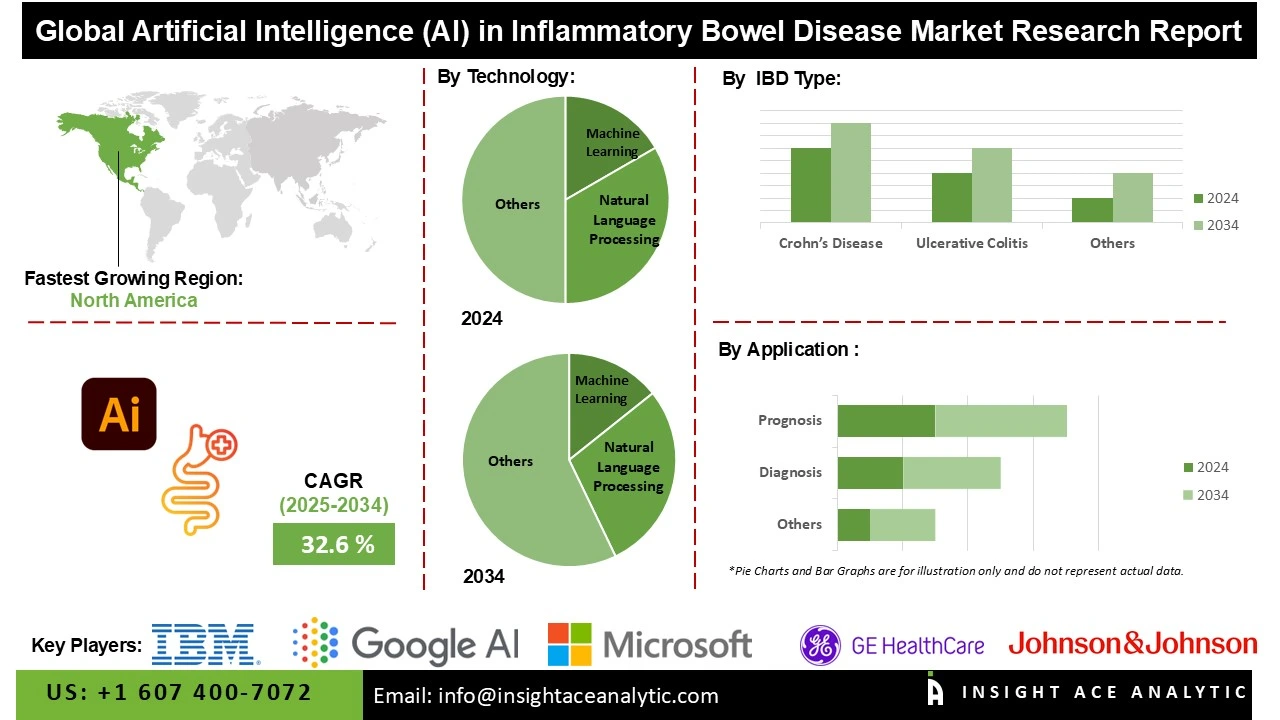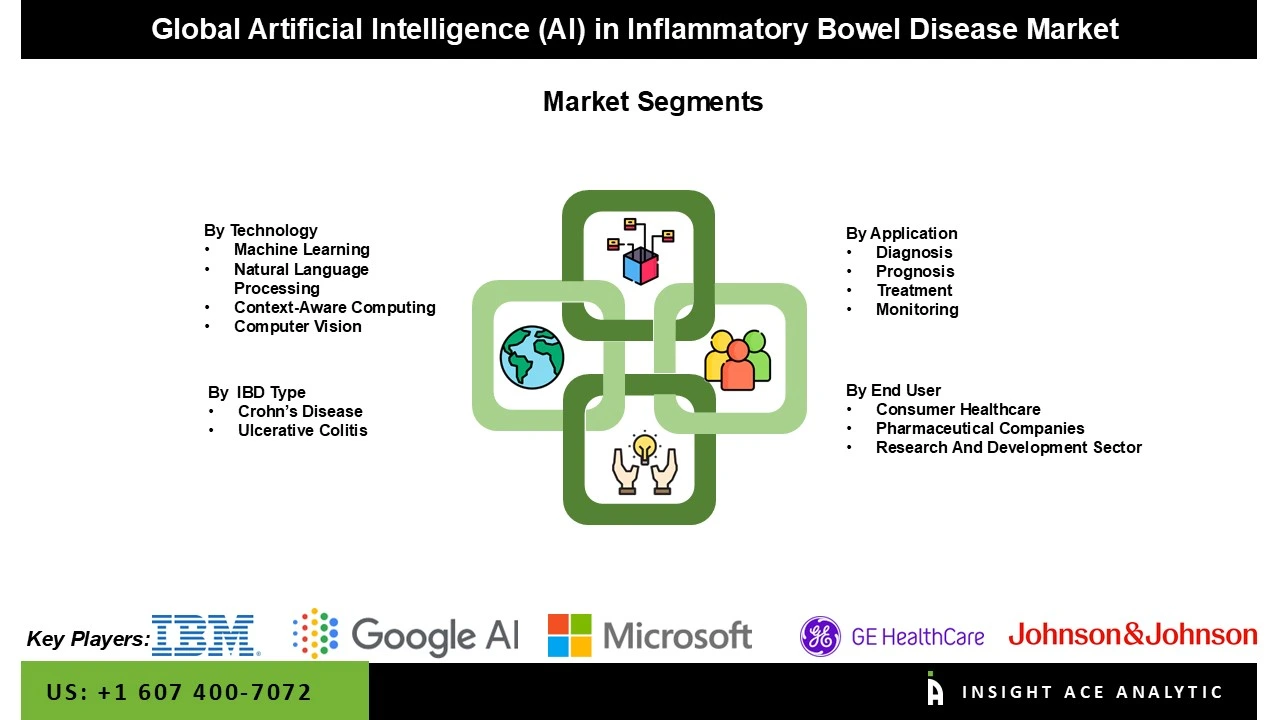Global AI In Inflammatory Bowel Disease Market Size is predicted to grow at an 32.6% CAGR during the forecast period for 2025-2034.
AI is essential for enhancing inflammatory bowel disease (IBD) diagnosis, management, and treatment. To identify inflammation, predict the severity of the condition, and track the effectiveness of treatment, analyzing endoscopic and imaging data is helpful. Personalized medicine, medication discovery, and biomarker identification are enabled by machine learning algorithms that leverage patient-specific data. Early identification of flare-ups and illness progression is made possible by AI-powered predictive models.

Based on patient-specific data, machine learning algorithms help identify biomarkers, optimize drug discovery, and personalize therapy. Predictive models powered by AI enable early identification of flare-ups and disease progression. More accurate and efficient treatment of IBD patients results from AI's support for clinical decision-making, automated data interpretation from medical records, and improved clinical trial efficiency.
The global market for AI in inflammatory bowel disease is expanding due to the rising incidence of IBD, growing adoption of AI-based diagnostic tools, and advancements in deep learning technologies. The rising incidence of IBD is another element propelling the AI in Inflammatory Bowel Disease market. With the increasing prevalence of inflammatory bowel diseases (IBD), there is a strong need for effective diagnostic and treatment solutions, boosting market growth. AI can streamline the treatment of individuals suffering from IBD and predict the need for surgery and future response to treatment. However, Healthcare professionals and patients may be reluctant to use AI solutions for IBD diagnosis and treatment if they are unaware of the technology's potential, and integration challenges with existing healthcare systems are among the obstacles to AI's growth in the inflammatory bowel disease sector. Over the forecast period, opportunities for AI in the inflammatory bowel disease market will be created by specific advancements, such as AI in telemedicine, which has also been shown to support symptom management and medication adherence.
Some of the Key Players in AI In Inflammatory Bowel Disease Market:
· IBM
· Google AI
· Microsoft
· GE Healthcare
· Johnson & Johnson
· Philips Healthcare
· Nuance Communications
· Zebra Technologies
· Medtronic
· Boston Scientific
· Olympus
· Mobius Care
· PathAI
· Abivax
· Quibim
The AI In inflammatory bowel disease market is segmented by technology, end-user, IBD type, and application. By technology, the market is segmented into machine learning, natural language processing, context-aware computing, and computer vision. By end-user, the market is segmented into consumer healthcare, pharmaceutical companies, and research and development sector. By ibd type, the market is segmented into crohn’s disease, and ulcerative colitis. By application, the market is segmented into diagnosis, prognosis, treatment, and monitoring.
The Machine Learning category led the AI in Inflammatory Bowel Disease market in 2024. This convergence is made possible by machine learning algorithms' ability to detect minute patterns and irregularities in patient data. Furthermore, individual patients' treatment programs can be customized using machine learning algorithms that consider their distinct traits and therapeutic responses. These tactics are seen to support the segment's expansion.
The largest and fastest-growing end-user is consumer healthcare, a trend driven by AI solutions designed to assist healthcare providers with many aspects of IBD care and targeted at clinical settings and healthcare institutions. The goal of AI solutions is to help medical professionals diagnose IBD accurately and efficiently. They could look at an array of data sources, including test results, patient symptoms, and medical imaging.
North America dominated the AI in inflammatory bowel disease market in 2024. The United States is at the forefront of this expansion. This is due to the high prevalence of inflammatory bowel diseases, advanced healthcare infrastructure, and the strong adoption of AI-based diagnostic tools. The regional growth is further supported by AI healthcare companies leading the market, research partnerships, and government funding in the development of digital health innovations. In the U.S.
Heightened digitization of healthcare, growing awareness of AI diagnostics, and the increasing prevalence of gastrointestinal illnesses in the Asia-Pacific region are driving the AI in Inflammatory Bowel Disease market to expand at the fastest rate in this region. Additionally, increased capital infusions into healthcare by countries such as China, India, and Japan, coupled with government policies supporting AI-related advancements, are also driving several of these factors. The rapid growth in medical infrastructure, increased research alliances, as well as, improved access to cost-effective AI tools are contributing to the robust growth momentum in this region.
AI In Inflammatory Bowel Disease Market by Technology-
· Machine Learning
· Natural Language Processing
· Context-Aware Computing
· Computer Vision

AI In Inflammatory Bowel Disease Market by End-User-
· Consumer Healthcare
· Pharmaceutical Companies
· Research And Development Sector
AI In Inflammatory Bowel Disease Market by IBD Type-
· Crohn’s Disease
· Ulcerative Colitis
AI In Inflammatory Bowel Disease Market by Application-
· Diagnosis
· Prognosis
· Treatment
· Monitoring
AI In Inflammatory Bowel Disease Market by Region-
North America-
· The US
· Canada
Europe-
· Germany
· The UK
· France
· Italy
· Spain
· Rest of Europe
Asia-Pacific-
· China
· Japan
· India
· South Korea
· Southeast Asia
· Rest of Asia Pacific
Latin America-
· Brazil
· Argentina
· Mexico
· Rest of Latin America
Middle East & Africa-
· GCC Countries
· South Africa
· Rest of the Middle East and Africa
Chapter 1. Methodology and Scope
1.1. Research Methodology
1.2. Research Scope & Assumptions
Chapter 2. Executive Summary
Chapter 3. Global Artificial Intelligence (AI) In Inflammatory Bowel Disease Market Snapshot
Chapter 4. Global Artificial Intelligence (AI) In Inflammatory Bowel Disease Market Variables, Trends & Scope
4.1. Market Segmentation & Scope
4.2. Drivers
4.3. Challenges
4.4. Trends
4.5. Investment and Funding Analysis
4.6. Porter's Five Forces Analysis
4.7. Incremental Opportunity Analysis (US$ MN), 2025-2034
4.8. Competitive Landscape & Market Share Analysis, By Key Player (2024)
4.9. Use/impact of AI on Artificial Intelligence (AI) In Inflammatory Bowel Disease Market Industry Trends
4.10. Global Artificial Intelligence (AI) In Inflammatory Bowel Disease Market Penetration & Growth Prospect Mapping (US$ Mn), 2024-2034
Chapter 5. Artificial Intelligence (AI) In Inflammatory Bowel Disease Market Segmentation 1: By Technology, Estimates & Trend Analysis
5.1. Market Share by Technology, 2024 & 2034
5.2. Market Size Revenue (US$ Million) & Forecasts and Trend Analyses, 2021 to 2034 for the following Technology:
5.2.1. Machine Learning
5.2.2. Natural Language Processing
5.2.3. Context-Aware Computing
5.2.4. Computer Vision
Chapter 6. Artificial Intelligence (AI) In Inflammatory Bowel Disease Market Segmentation 2: IBD Type, Estimates & Trend Analysis
6.1. Market Share by IBD Type, 2024 & 2034
6.2. Market Size Revenue (US$ Million) & Forecasts and Trend Analyses, 2021 to 2034 for the following IBD Type:
6.2.1. Crohn’s Disease
6.2.2. Ulcerative Colitis
Chapter 7. Artificial Intelligence (AI) In Inflammatory Bowel Disease Market Segmentation 3: By Application, Estimates & Trend Analysis
7.1. Market Share by Application, 2024 & 2034
7.2. Market Size Revenue (US$ Million) & Forecasts and Trend Analyses, 2021 to 2034 for the following Application:
7.2.1. Diagnosis
7.2.2. Prognosis
7.2.3. Treatment
7.2.4. Monitoring
Chapter 8. Artificial Intelligence (AI) In Inflammatory Bowel Disease Market Segmentation 4: By End User, Estimates & Trend Analysis
8.1. Market Share by End User, 2024 & 2034
8.2. Market Size Revenue (US$ Million) & Forecasts and Trend Analyses, 2021 to 2034 for the following End User:
8.2.1. Consumer Healthcare
8.2.2. Pharmaceutical Companies
8.2.3. Research And Development Sector
Chapter 9. Artificial Intelligence (AI) In Inflammatory Bowel Disease Market Segmentation 5: Regional Estimates & Trend Analysis
9.1. Global Artificial Intelligence (AI) In Inflammatory Bowel Disease Market, Regional Snapshot 2024 & 2034
9.2. North America
9.2.1. North America Artificial Intelligence (AI) In Inflammatory Bowel Disease Market Revenue (US$ Million) Estimates and Forecasts by Country, 2021-2034
9.2.1.1. US
9.2.1.2. Canada
9.2.2. North America Artificial Intelligence (AI) In Inflammatory Bowel Disease Market Revenue (US$ Million) Estimates and Forecasts by Technology, 2021-2034
9.2.3. North America Artificial Intelligence (AI) In Inflammatory Bowel Disease Market Revenue (US$ Million) Estimates and Forecasts by IBD Type, 2021-2034
9.2.4. North America Artificial Intelligence (AI) In Inflammatory Bowel Disease Market Revenue (US$ Million) Estimates and Forecasts by Application, 2021-2034
9.2.5. North America Artificial Intelligence (AI) In Inflammatory Bowel Disease Market Revenue (US$ Million) Estimates and Forecasts by End User, 2021-2034
9.3. Europe
9.3.1. Europe Artificial Intelligence (AI) In Inflammatory Bowel Disease Market Revenue (US$ Million) Estimates and Forecasts by Country, 2021-2034
9.3.1.1. Germany
9.3.1.2. U.K.
9.3.1.3. France
9.3.1.4. Italy
9.3.1.5. Spain
9.3.1.6. Rest of Europe
9.3.2. Europe Artificial Intelligence (AI) In Inflammatory Bowel Disease Market Revenue (US$ Million) Estimates and Forecasts by Technology, 2021-2034
9.3.3. Europe Artificial Intelligence (AI) In Inflammatory Bowel Disease Market Revenue (US$ Million) Estimates and Forecasts by IBD Type, 2021-2034
9.3.4. Europe Artificial Intelligence (AI) In Inflammatory Bowel Disease Market Revenue (US$ Million) Estimates and Forecasts by Application, 2021-2034
9.3.5. Europe Artificial Intelligence (AI) In Inflammatory Bowel Disease Market Revenue (US$ Million) Estimates and Forecasts by End User, 2021-2034
9.4. Asia Pacific
9.4.1. Asia Pacific Artificial Intelligence (AI) In Inflammatory Bowel Disease Market Revenue (US$ Million) Estimates and Forecasts by Country, 2021-2034
9.4.1.1. India
9.4.1.2. China
9.4.1.3. Japan
9.4.1.4. Australia
9.4.1.5. South Korea
9.4.1.6. Hong Kong
9.4.1.7. Southeast Asia
9.4.1.8. Rest of Asia Pacific
9.4.2. Asia Pacific Artificial Intelligence (AI) In Inflammatory Bowel Disease Market Revenue (US$ Million) Estimates and Forecasts by Technology, 2021-2034
9.4.3. Asia Pacific Artificial Intelligence (AI) In Inflammatory Bowel Disease Market Revenue (US$ Million) Estimates and Forecasts by IBD Type, 2021-2034
9.4.4. Asia Pacific Artificial Intelligence (AI) In Inflammatory Bowel Disease Market Revenue (US$ Million) Estimates and Forecasts by Application, 2021-2034
9.4.5. Asia Pacific Artificial Intelligence (AI) In Inflammatory Bowel Disease Market Revenue (US$ Million) Estimates and Forecasts by End User, 2021-2034
9.5. Latin America
9.5.1. Latin America Artificial Intelligence (AI) In Inflammatory Bowel Disease Market Revenue (US$ Million) Estimates and Forecasts by Country, 2021-2034
9.5.1.1. Brazil
9.5.1.2. Mexico
9.5.1.3. Rest of Latin America
9.5.2. Latin America Artificial Intelligence (AI) In Inflammatory Bowel Disease Market Revenue (US$ Million) Estimates and Forecasts by Technology, 2021-2034
9.5.3. Latin America Artificial Intelligence (AI) In Inflammatory Bowel Disease Market Revenue (US$ Million) Estimates and Forecasts by IBD Type, 2021-2034
9.5.4. Latin America Artificial Intelligence (AI) In Inflammatory Bowel Disease Market Revenue (US$ Million) Estimates and Forecasts by Application, 2021-2034
9.5.5. Latin America Artificial Intelligence (AI) In Inflammatory Bowel Disease Market Revenue (US$ Million) Estimates and Forecasts by End User, 2021-2034
9.6. Middle East & Africa
9.6.1. Middle East & Africa Wind Turbine Rotor Blade Market Revenue (US$ Million) Estimates and Forecasts by country, 2021-2034
9.6.1.1. GCC Countries
9.6.1.2. Israel
9.6.1.3. South Africa
9.6.1.4. Rest of Middle East and Africa
9.6.2. Middle East & Africa Artificial Intelligence (AI) In Inflammatory Bowel Disease Market Revenue (US$ Million) Estimates and Forecasts by Technology, 2021-2034
9.6.3. Middle East & Africa Artificial Intelligence (AI) In Inflammatory Bowel Disease Market Revenue (US$ Million) Estimates and Forecasts by IBD Type, 2021-2034
9.6.4. Middle East & Africa Artificial Intelligence (AI) In Inflammatory Bowel Disease Market Revenue (US$ Million) Estimates and Forecasts by Application, 2021-2034
9.6.5. Middle East & Africa Artificial Intelligence (AI) In Inflammatory Bowel Disease Market Revenue (US$ Million) Estimates and Forecasts by End User, 2021-2034
Chapter 10. Competitive Landscape
10.1. Major Mergers and Acquisitions/Strategic Alliances
10.2. Company Profiles
10.2.1. IBM
10.2.1.1. Business Overview
10.2.1.2. Key Type /Service Overview
10.2.1.3. Financial Performance
10.2.1.4. Geographical Presence
10.2.1.5. Recent Developments with Business Strategy
10.2.2. Google AI
10.2.3. Microsoft
10.2.4. GE Healthcare
10.2.5. Johnson & Johnson
10.2.6. Philips Healthcare
10.2.7. Nuance Communications
10.2.8. Zebra Technologies
10.2.9. Medtronic
10.2.10. Boston Scientific
10.2.11. Olympus